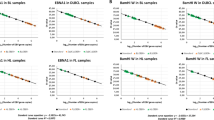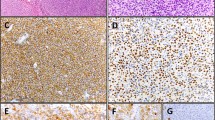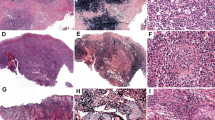Abstract
Burkitt’s lymphoma (BL) in Turkish children is commonly associated with Epstein–Barr virus (EBV) infection. The C-terminus of the latent membrane protein 1 (LMP-1) of EBV is essential for transformation and the 30-bp deletion detected in this region has been implicated to be associated with a more aggressive malignant phenotype. To understand the molecular mechanisms underlying EBV pathogenesis in BL of Turkish children, we analyzed 30-bp deletion and 33-bp variable repeat regions of the LMP-1 gene from paraffin-embedded tumor tissues of 30 BL patients (mean age 5.9 years). Primer pairs spanning the 30-bp deletion and 33-bp repeat regions were designed for amplification by polymerase chain reaction (PCR). The PCR-amplified products were analyzed by gel electrophoresis, Southern blot hybridization, and DNA sequencing. Twenty-eight (93%) of 30 BL biopsy samples were EBV positive as determined by PCR. Variable copy numbers (ranging from 4.5 to 7) of the 33-bp repeat of LMP-1 gene were detected in these EBV-containing tumor samples. To determine the frequency of the 30-bp deletion of the LMP-1 gene, we sequenced the amplimers encompassing this region. Analyses of DNA sequence of 28 Turkish BLs have disclosed four patterns: the first (32% (9/28)) is identical to B95–8 with no deletion, the second (11% (3/28)) is identical to Asian NPC CAO strain with 30-bp deletion, the third (46% (13/28)) is prevalent in Turkish BLs with a longer deletion (69 bp), and the fourth (11% (3/28)) consists of a mixture of 30-bp and 69-bp deletion. The occurrence of high frequency of the 69-bp deletion appears to have no correlation with the disease site. Mutations found in the CAO strain were also detected in the Turkish BL clustering at the amino acids 322, 334, 338 and 342; whereas mutations specific for Turkish BL were clustered at amino acids 326, 352 and 361. To assess the EBV genotype with the changes in C-terminus of LMP-1 gene, we performed genotyping by PCR to differentiate type A and B strain. All 28 patients were infected by type A EBV. Such a high frequency of the larger size (69 bp) deletion has never been reported. Ascertaining the role of this deletion in BL pathogenesis will require further study.
This is a preview of subscription content, access via your institution
Access options
Subscribe to this journal
Receive 12 print issues and online access
$259.00 per year
only $21.58 per issue
Buy this article
- Purchase on Springer Link
- Instant access to full article PDF
Prices may be subject to local taxes which are calculated during checkout
Similar content being viewed by others
Author information
Authors and Affiliations
Rights and permissions
About this article
Cite this article
Tacyildiz, N., Cavdar, A., Ertem, U. et al. Unusually high frequency of a 69-bp deletion within the carboxy terminus of the LMP-1 oncogene of Epstein–Barr virus detected in Burkitt’s lymphoma of Turkish children. Leukemia 12, 1796–1805 (1998). https://doi.org/10.1038/sj.leu.2401203
Received:
Accepted:
Published:
Issue Date:
DOI: https://doi.org/10.1038/sj.leu.2401203
Keywords
This article is cited by
-
Detection and genotyping of CMV and HPV in tumors and fallopian tubes from epithelial ovarian cancer patients
Scientific Reports (2019)
-
Identification of a novel variant of LMP-1 of EBV in patients with endemic Burkitt lymphoma in western Kenya
Infectious Agents and Cancer (2013)
-
Prognostic Significance of Cell Proliferation and Apoptosis-Regulating Proteins in Epstein-Barr Virus Positive and Negative Pediatric Non-Hodgkin’s Lymphoma
Pathology & Oncology Research (2009)



